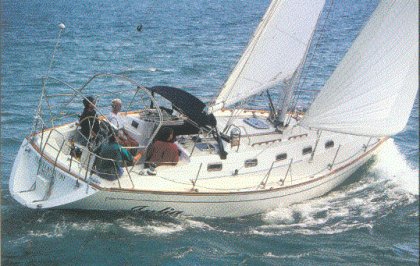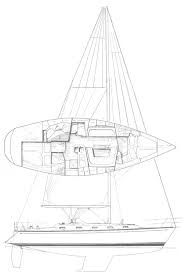
The Tartan 3800 was already under way when Boat Of The Year judges approached in
a support tender for the test sail. We were impressed by its good looks and
functional styling. The exterior teak toe rails, handholds and Dorade boxes
added to the proper yacht ambience, and although from a distance the wood trim
appeared to be varnished, in fact it was oiled with Sikkens Setol, a penetrating
finish.
On deck, the traditional cabin house and excellent non-skid made moving around
easy. The flush anchor locker forward had ample room for an anchor winch. The
cockpit was compact, but very comfortable, and the Harken 48 self-tailing
jib-sheet winches were placed sensibly, for use by either helmsman or crew.
Mainsheet, traveler, all halyards and reef lines were led to size-32 winches and
stoppers on the aft edge of the cabin house. The aluminum mast by Offshore Spars
was keel-stepped and had in-line double spreaders and continuous wire rigging. A
permanent baby stay brought up to the lower spreaders stabilized against pumping
even without the use of running backstays.
The Interior
The accommodations featured one double stateroom forward and one aft. While
there was only one head on the 3800 we viewed, an extra washbasin in the forward
stateroom proved to be a handy added convenience. The head layout was
thoughtful, with a separate shower stall and wet locker. Hanging lockers were
cedar lined, but were fitted with old-fashioned “finger through a hole” latches
instead of the more modern push buttons, a possible concern in bumpy conditions.
The galley’s general layout was excellent with the sink close to centerline for
good draining on either tack. The icebox, large and deep, included both top and
front openings, but provisions would have to be stowed on the shelves with some
forethought for access when needed. The stove gimballed 40 degrees on port tack,
but only 25 degrees on starboard due to easily remedied interference by a piece
of trim.
Ventilation included four good Dorade boxes, four Lewmar hatches and 11
stainless opening portlights. Errant salt spray in the galley and navigation
areas was opposed by good side panels to port and starboard of the companionway.
Construction

The hull is hand-laminated using unidirectional E glass, with balsa core in the
topsides and a solid laminate below the waterline. The deck is fiberglass with
balsa core as well, substituted where necessary by solid laminate with backing
plates for the bolting of all deck hardware. The Tartan 3800 has ABS-approved
plans and an optional ABS certificate is available.
The deck is sealed to an inward flange of the hull with 3M 5200 polyurethane
adhesive. Screws holding the wood toe rail tap into a 6061 T-6 aluminum strip
which itself is glassed into the hull flange. Tartan presented a very good
cross-sectional segment of the hull to show this. Both hull and deck had
interior liners. Removable cover panels in the overhead gave access to specific
deck-gear bolts; in addition, the entire overhead could be taken down, if
necessary.
We sailed a 3800 with the standard 5’4″ “beavertail” keel. The boat sailed very
well with the shoal-draft keel and two-bladed fixed-pitch propeller. A 6’10”
high-lift elliptical keel is available for higher performance.
In summary, Tartan has continued an excellent tradition of building solid,
honest cruising boats that pack enough performance for good passage making and
even racing at the club level. Inside and out, this boat has all the features a
good cruising boat should have. As one of our judges with several years of
serious cruising behind her said, “I could easily picture myself sailing around
the world in this handsome boat.”
— Bill Lee
The Tartan 3800 is a sensible cruising boat. Other builders may strive for
styling that ranges from atavistic to modern, but this design, simply, does the
important things well. It is comfortable to work or relax aboard, the
construction is conservative, and the boat’s profile will please the eye as much
in 10 years as it does today. The list of standard features is long, the list of
options short, keeping the final price within the same orbit as the base price.
The base price of the standard model is $169,000; the boat that we tested cost
about $190,000, which included dealer options such as Harken furling, B&G
electronics, a dodger and North sails. Other options include refrigeration,
spinnaker gear and secondary winches. Standard equipment includes the teak
interior, Corian counters and shore power. As of September, with eight 3800s
built, a dealer said that a typical sail-away price was about $195,000. The
company can build this boat in eight to 10 weeks.
Under Sail
During the test sail, we hoisted the full-battened mainsail and unrolled the
genoa in winds up to 15 knots. The North sails set nicely and allowed us to tack
thorough 80 to 85 degrees. The traveler was just forward of the dodger, which
allowed both mainsheet and traveler to be controlled on the cabin top. The helm
was easy except for slight drag from the wheel-mounted autopilot. Most of the
Boat Of The Year judges liked the feel even though the steering seemed a bit
numb, perhaps due to a slightly overbalanced spade, and even though the wake
indicated that we were using a good bit of rudder angle on the wind. But there
again, we had lots of sail up and 20 knots of wind over the deck. We were not
dramatically heeled, indicating that the boat was quite stiff even with the
shoal-draft keel. When we reefed, we maintained speed and happily we used less
helm. The single-line reefing worked smoothly. Needless to say, the boat was
responsive and forgiving. It even hove to easily, which is certainly a
convenient maneuver — even in moderate breeze — should something demand the
helmsman’s attention elsewhere.
Cockpit and Interior
The wheel was easy to step around and the cockpit layout overall functioned well
even with five people in it. There were handholds and secure footing as needed
above and belowdeck. All of the accommodations were nicely proportioned for a
38-footer — no wasted space, no conflicting elements. The galley was functional
and the chart table faced forward in a generous niche. The tankage was quite
adequate for a cruising sailboat: a 38-gallon fuel tank, an 80-gallon water tank
and a 24-gallon holding tank. We easily accessed the 37-horsepower,
four-cylinder Westerbeke by lifting the molded companionway steps. There was
additional access through two side-panel doors.
Tartan shows that lowest initial cost is not the sole measure of value. The
quality and longevity of a product are increasingly important factors in the
long run. For instance it is good to know that the thru-bolted deck equipment
can be accessed easily for rebedding or replacing down the road, or that the
solid laminate beneath fittings will not have leaked water into balsa core.
Tartan uses bronze seacocks throughout for their strength and resilience.
Tartan Yachts has found models of this size range very popular. From 1976 to
1989, they built 486 Tartan 37s — a Sparkman & Stephens design. The 3800,
designed by Tim Jackett, was introduced in 1994. By year’s end the company was
already building hull #14. Their plant has been in full swing over the winter
building the Tartan 3100, 3500, 3800 and 4600. They were also well into building
the tooling for a new 41-footer. The company has had an impressive history and,
from what we can see, it has an impressive future.
— Sheila McCurdy
TARTAN 3800 SPECIFICATIONS:
LOA: 38’0″ (11.6 m.)
LWL 31’0″ (9.5 m.)
Beam 12’5″ (3.8 m.)
Draft 6’10” (2.1 m.)
Draft (shoal) 5’4″ (1.6 m.)
Ballast 6500/7000 lbs. (2950/3175 kgs.)
Displacement 16,000 lbs. (7258 kgs.)
Sail Area 672 sq. ft. (62.4 sq. m.)
Mast Above Water 55’0″ (16.8 m.)
Ballast/Disp. .41/.44
Disp/Length 239.8
SA/Disp 17
Fuel Tankage 38 gal. (144 l.)
Water Tankage 80 gal. (303 l.)
Auxiliary Westerbeke 37-hp. diesel
Cabin Headroom 6’5″ (1.96 m.)
Designer Tim Jackett
Base Price $169,000
Tartan Yachts
320 River St.
Grand River, OH 44045
Phone (216) 354-3111








